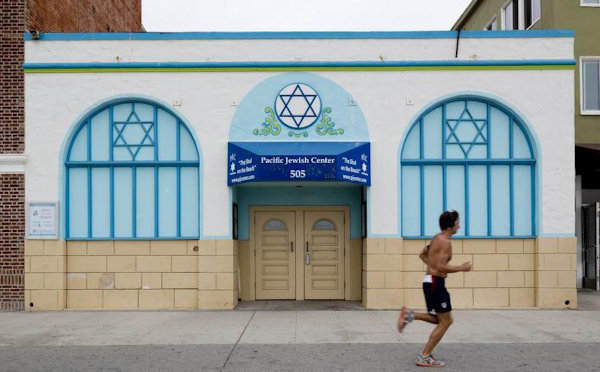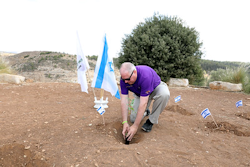SEJournal Online is the digital news magazine of the Society of Environmental Journalists. Learn more about SEJournal Online, including submission, subscription and advertising information.
 |
 |
| The stories of American and Israeli Jews have grown increasingly disconnected. For one, the answer is engagement in progressive social causes, for the other, statehood. Above, the Pacific Jewish Center in Los Angeles, California. Photo: Carol Highsmith, Library of Congress. |
Feature: Making Sense of Jewish Perspectives on the Climate Story
By Ethan Brown
As a Jewish climate journalist, I had the chance to travel to Israel this spring for the second time in my life. This trip came a month after moderating a “Jews and Climate Change” beat breakfast at the 2024 Society of Environmental Journalists conference in Philadelphia, where I spoke with two leaders at American Jewish climate organizations: Jennie Rosenn, the CEO of Dayenu, and Adamah chief program officer Yoni Stadlin.
There were many good reasons to dedicate a beat breakfast to talking about Jews and climate action, especially in an election year (see sidebar below).
But as we spoke to attendees in the leadup, we quickly learned most had a different topic in mind: Israel.
Our panel of three American Jews working on climate in the United States had no plans to cover Israel. But now, having just spent two months in Israel meeting new people and asking tough questions, I can report back some of the key differences between Israeli Jewish environmentalism and the American Jewish environmentalism we explored at the conference.
In short, the two philosophies have diverged, but both bring very intriguing and consequential stories.
Elephant in the room
Current events in Israel and Gaza are momentous, to say the least.
Specifically, as Israel’s war with Hamas pertains to the environment, journalists have written about how Israel has destroyed Palestinian farmland, pumped seawater into Hamas’ underground tunnels, used white phosphorus and amassed a significant carbon footprint.
Meanwhile, since Hamas’ Oct. 7 attack, Hezbollah has also destroyed thousands of acres of northern Israeli forests via rocket attacks, Houthis struck a cargo ship with over 41,000 tons of fertilizer causing an 18-mile oil slick, and Hamas has continued their practice of stealing aid intended for water and sewage management and pulling (subscription required) sewer pipes out of the ground to turn into rockets.
Wartime environmental damage is
devastating, and journalists must cover it.
But the stories of American and Israeli Jews
have grown increasingly disconnected.
Wartime environmental damage is devastating and journalists must cover it. But the stories of American and Israeli Jews have grown increasingly disconnected.
Understanding these dynamics can help environmental journalists uncover Jewish outlooks on consequential climate stories in both the United States and Israel, and thoughtfully place them within this particularly challenging moment in history.
One people, two stories
Following the Holocaust, the global Jewish community had to answer some difficult questions. Who are we? How do we fit into the world around us? What will keep us safe?
For Israeli Jews, the answer was statehood. If we can have our own state with our own government and military, they believed, we can grow strong and protect ourselves.
For American Jews, the answer was tikkun olam, the Jewish practice of “repairing the world.” If we engage in progressive social causes, we can make the world safer around us — which in turn will keep us safe.
This oversimplified narrative helps explain the divergence of Israeli and American Jewish environmentalism.
Israelis focus on innovation and strengthening the state — engineers have developed desalination and drip irrigation, entrepreneurs have launched over 850 clean tech companies and export technologies around the world, and local kibbutzim have forged land management strategies centered on collective farming and self-sufficiency in large part to help global Jews more easily migrate to Israel.
Americans, rather, focus on building political influence and engaging in progressive movements.
Of course, all Jews share some environmental traditions. They include land-based holidays like Tu BiShvat, or the “birthday” of trees, and the harvest festival Sukkot. And there are also the biblical teachings of Shomrei Adamah, the idea of being guardians of the land, Bal Tashchit, or the admonition against wanton destruction, and Pikuach Nefesh, or the preservation of life.
There are also intriguing synergies between Israeli and American Jewish environmentalism — for example, an Israeli startup launched a clean water partnership with an Emirati firm in 2020, a peace opportunity made possible by the Abraham Accords, which the United States negotiated that year.
But each group’s environmentalism still has its own ethos — something I didn’t fully grasp until moderating the SEJ panel discussion and then going back to Israel for a second time. The brief overview above might help explain why we felt a “Jews and Climate Change” discussion had nothing to do with current events in Israel.
Understand American Jews’ motivations, apprehensions
So how can environmental journalists better approach and contextualize stories within each community? Here are some ideas to get you started.
In the United States, cover Jewish environmental stories here.
Learn about our motivations to vote, donate, divest, organize, practice tikkun olam and care so passionately about climate change.
Empathize if sources don’t feel comfortable sharing thoughts about Israel — in most cases, it’s genuinely not part of the American Jewish environmental story.
Also keep in mind that American Jewish environmentalists are not experts in wartime environmental damage — and they certainly can’t answer for it.
Jews will undoubtedly play a critical role
in the 2024 election and have recently
achieved remarkable climate wins in
political lobbying and community organizing.
Jews will undoubtedly play a critical role in the 2024 election and have recently achieved remarkable climate wins in political lobbying and community organizing. Please don’t hesitate to reach out about that and share our stories.
See Israel for yourself, ask hard questions
There are also stories in Israel. Some are devastating; others are hopeful.
 |
| Former Maryland Gov. Larry Hogan plants a tree at the Neot Kedumin nature preserve in Israel in 2016. The country is the only one on the planet that had more trees in the year 2000 than in 1900. Photo: Maryland GovPics via Flickr Creative Commons (CC by 2.0). |
If you have the opportunity, travel there and see for yourself. Ask hard questions. Resist the urge to view Israeli environmentalism through an American or tikkun olam lens.
For instance, Israel ranked No. 6 on the 2017 Global Cleantech Innovation Index and is the only country on Earth with more trees in the year 2000 than in 1900. These accomplishments weren’t due to social progressivism, but that doesn’t mean they’re greenwashing either.
Let the confusion about this Zionist environmentalism drive questions, tough conversations and stories.
Post Oct. 7, understand that Israelis overwhelmingly disapprove of their current government. Remember how you covered climate change under objectionable American presidents.
At our SEJ panel, one audience member asked if I felt traveling to Israel as a journalist was “making a political statement.”
My feeling is: Even if we disagree with a government, there are still people and communities with important stories and solutions, and it’s our job as journalists to find them and share them. It’s also our job to hold leaders accountable, and only by traveling to the source can we ensure our coverage is factual, unbiased and effective.
Seek stories of collaboration
Lastly, look for the bridge builders.
Israel has several stories of Jews collaborating with Palestinians, Jordanians, Egyptians and other majority-Muslim neighbors on climate solutions.
And in the United States, building bridges is at the cornerstone of a Jewish community that only comprises 2.4% of the population but has high ambitions for social and environmental progress.
A few hours after our beat breakfast, conference attendees had the opportunity to hear from Tareq Abu Hamed, executive director of the Arava Institute for Environmental Studies, at a panel on the environmental consequences of war (audio recording).
Abu Hamed was once the highest-ranking Palestinian in the Israeli government and now works to bring Israeli, Palestinian and international students together to work on climate solutions as a peacebuilding opportunity.
I had the opportunity to interview him on my podcast last year and to visit Kibbutz Ketura (home of the Arava Institute) in June, and I was so inspired by all they do.
At the end of the day, in 2024, the expression “two Jews, three opinions” could not ring truer.
By recognizing the broader Jewish community’s challenges and embracing our individuality, journalists can report on consequential Jewish perspectives on climate solutions in the United States and Israel, and accept the fact that our story is full of very intriguing puzzle pieces that, as of now, don’t really fit together.
SIDEBAR: Political Clout and Climate ActionAmerican Jews have successfully mobilized several climate-related efforts, and especially in an election year, there are many climate stories within the community to explore. Jews, for example, are more likely to view climate change as a “crisis” than any other U.S. religious group. Jews also vote at a higher rate than other demographics. Jews vote overwhelmingly Democratic and represent 2.3% of the electorate in Pennsylvania, 1.5% in Arizona and 1.2% in Georgia — critical states that President Biden won by 1.2%, 0.4% and 0.3% respectively. On the ground, activists at Dayenu: A Jewish Call to Climate Action played a role in pushing Jewish legislators to pass the Inflation Reduction Act and connect the bill’s passage with Tisha B’Av, a Jewish holiday commemorating historical destruction and rebuilding. Jewish donors also contribute 50% of the Democratic party’s funds and 25% of the Republican party’s funds. It’s not just politics. Adamah, the largest Jewish environmental organization in North America, has mobilized a Jewish Climate Leadership Coalition with over 200 members and engaged 20,000 people in immersive retreats and Jewish environmental education. And earlier this year, the Union for Reform Judaism, representing three million American Jews, approved a resolution recommending its institutions pull their money out of fossil fuels and engage in shareholder advocacy with other polluting industries. |
[Editor’s Note: Material for this story was drawn in part from a beat breakfast moderated by the author at the Society of Environmental Journalists’ annual conference in Philadelphia in April 2024, whose sponsors are listed here. Sponsored beat breakfasts are independently organized by the hosts, who are solely responsible for any content, speakers or materials. This beat breakfast was sponsored by the Mizrahi Family Charitable Fund (a donor-advised fund).]
Ethan Brown is a Jewish freelance environmental writer and a program consultant at Metcalf Institute. He founded the PBS award-winning comedy climate podcast The Sweaty Penguin, focused on combating climate anxiety and polarization. He holds a B.A. in environmental analysis and policy from Boston University, and was recently named Covering Climate Now’s Emerging Journalist of the Year.
* From the weekly news magazine SEJournal Online, Vol. 9, No. 31. Content from each new issue of SEJournal Online is available to the public via the SEJournal Online main page. Subscribe to the e-newsletter here. And see past issues of the SEJournal archived here.













 Advertisement
Advertisement 



